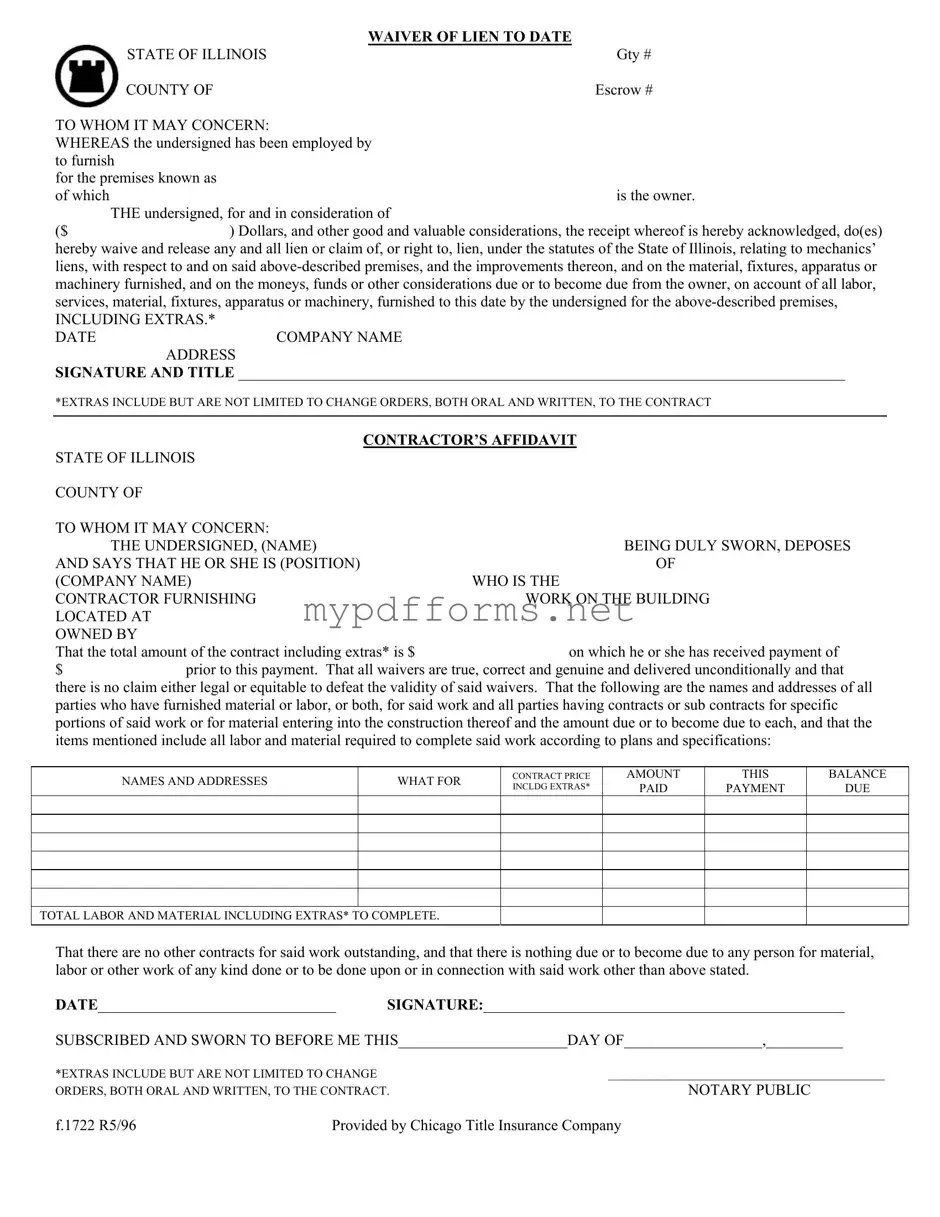The Chicago Title Waiver Format form shares similarities with the Mechanic's Lien Waiver, a common document used in construction and renovation projects. Like the Chicago Title Waiver, the Mechanic's Lien Waiver serves to protect property owners from potential claims by contractors or subcontractors for unpaid work. Both documents release any lien rights that the contractor or subcontractor may have against the property, ensuring that once payment is made, the owner is free from future claims related to that work. This mutual understanding fosters trust between parties and clarifies financial responsibilities.
Another document akin to the Chicago Title Waiver is the Partial Lien Waiver. This waiver is often used when a contractor receives a partial payment for work completed up to a certain point. Similar to the Chicago Title Waiver, it releases the right to file a lien for the amount that has been paid. However, unlike the full waiver, it does not relinquish the right to claim a lien for any remaining unpaid balance. This document ensures that the contractor acknowledges receipt of payment while still retaining rights for any outstanding amounts owed.
The Final Lien Waiver is also comparable to the Chicago Title Waiver. This document is executed at the end of a project when the contractor has received full payment for all work performed. It formally releases any lien rights the contractor may have had against the property, similar to the Chicago Title Waiver. By signing this document, the contractor confirms that they have been paid in full and that there are no outstanding claims, providing peace of mind to the property owner.
The Contractor’s Affidavit bears similarities to the Chicago Title Waiver as well. This affidavit requires the contractor to swear that they have fulfilled their obligations and that all subcontractors and suppliers have been paid. Like the Chicago Title Waiver, it serves to protect the property owner from future claims. It provides assurance that the contractor is in good standing and that all financial responsibilities have been met, thereby minimizing the risk of potential liens.
The Subcontractor Lien Waiver is another document that parallels the Chicago Title Waiver. This waiver is specifically designed for subcontractors who have worked on a project. It releases the property owner from any lien claims by the subcontractor for the work performed. Similar to the Chicago Title Waiver, it requires the subcontractor to acknowledge receipt of payment, ensuring that the owner is not liable for any unpaid claims from the subcontractor.
The Release of Lien is a document that is often used in conjunction with the Chicago Title Waiver. This release is typically executed after payment has been made and serves to formally document that the contractor or subcontractor has relinquished any lien rights against the property. Both documents aim to protect the property owner and confirm that all parties have settled their financial obligations, thus preventing any future disputes.
The Statement of Account is another document that aligns with the Chicago Title Waiver. This statement outlines the financial transactions between the contractor and the property owner, detailing the amounts paid and any outstanding balances. While the Chicago Title Waiver focuses on releasing lien rights, the Statement of Account provides a comprehensive overview of the financial relationship, ensuring transparency and clarity for both parties involved.
For those looking to transfer ownership of a mobile home, a reliable guide is available with the necessary Mobile Home Bill of Sale requirements to complete your transaction securely.
Lastly, the Notice of Intent to Lien is similar in purpose to the Chicago Title Waiver, albeit from a different perspective. This document is typically sent by contractors or subcontractors to inform property owners of their intent to file a lien if payment is not received. While the Chicago Title Waiver releases lien rights, the Notice of Intent serves as a warning and a reminder of the financial obligations owed. Both documents play crucial roles in the construction industry, emphasizing the importance of clear communication and financial accountability.
